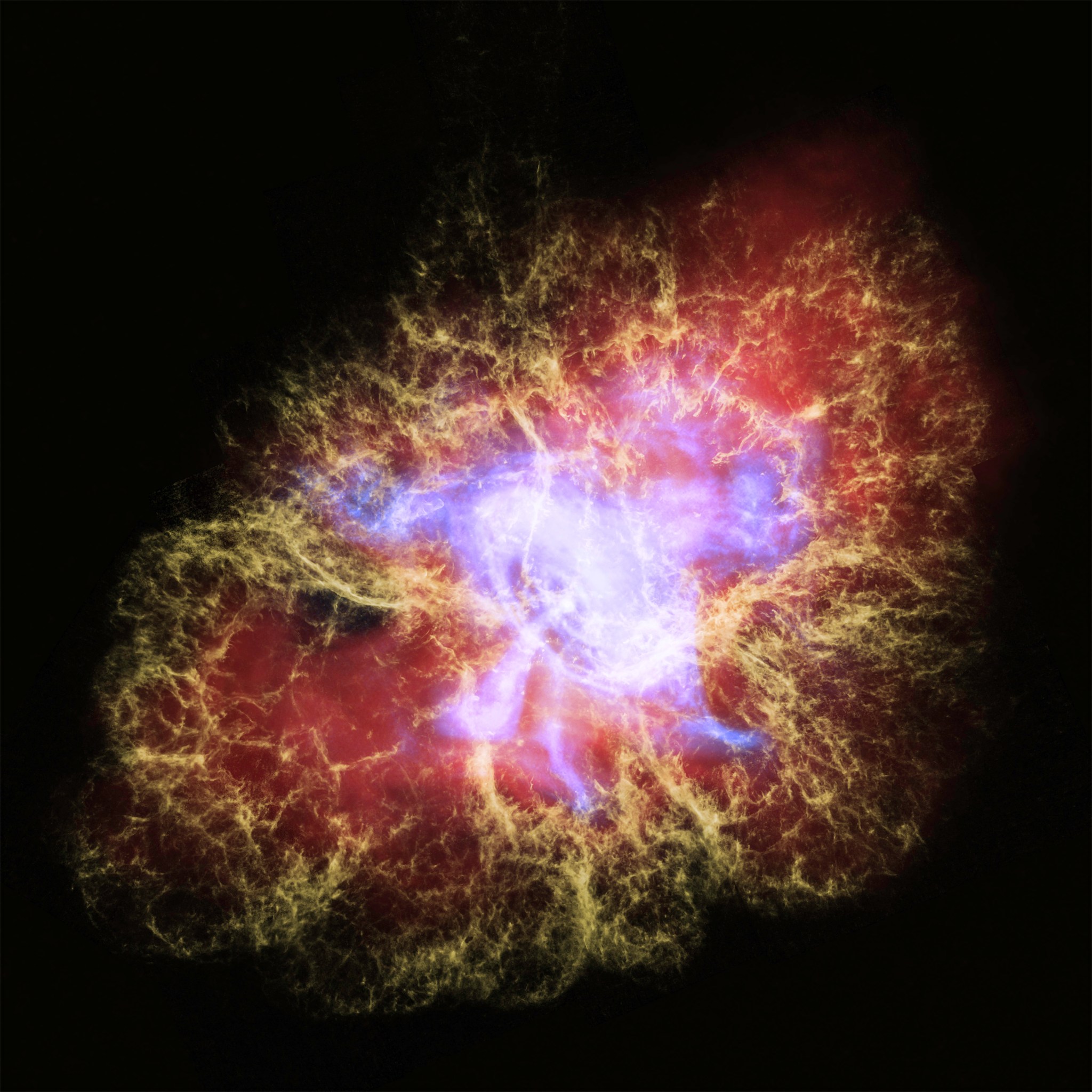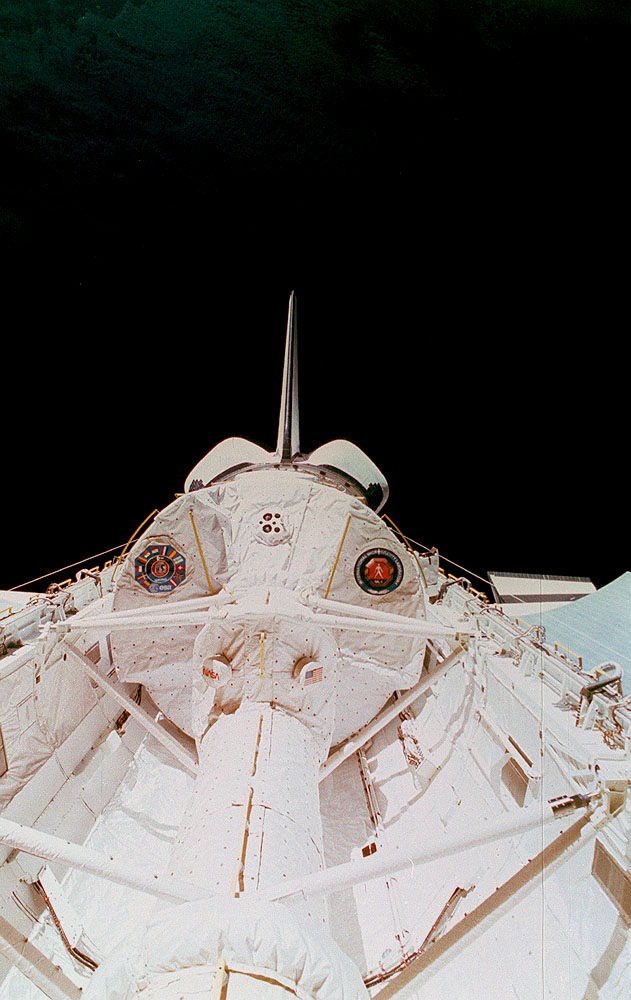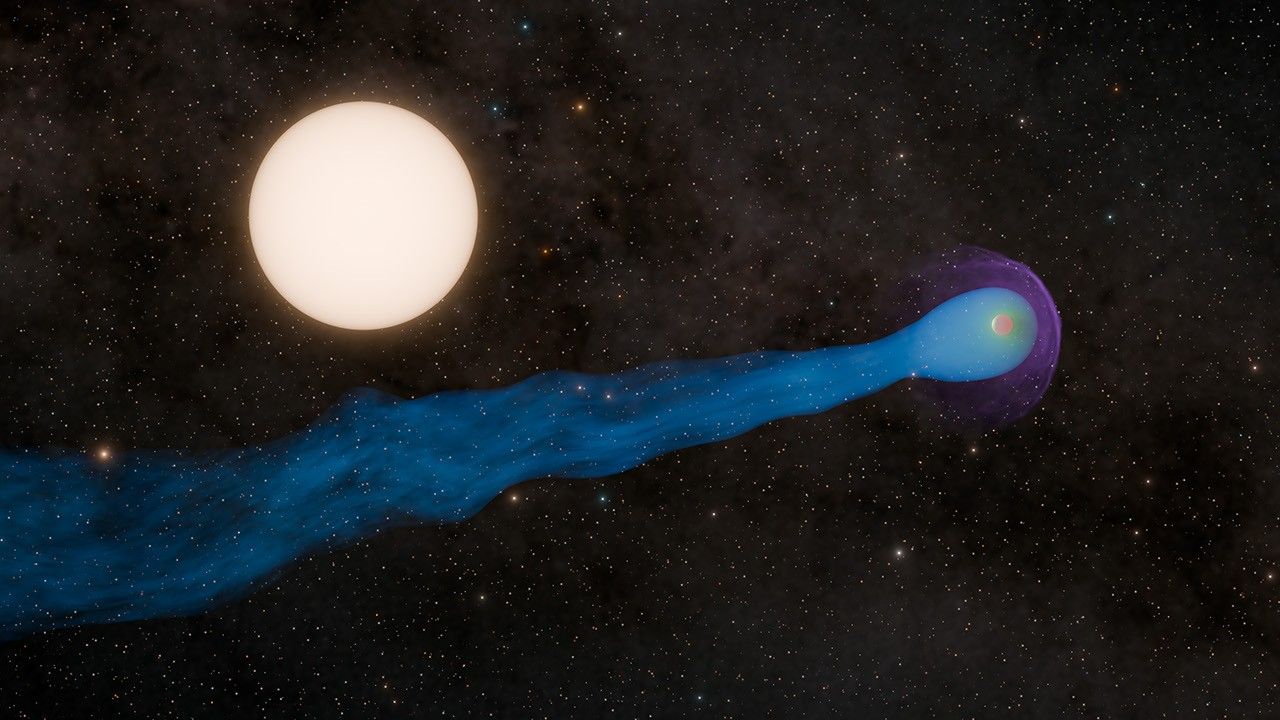In This Week’s Star
- Take 5 with Neil Rodgers
- Marshall Director Jody Singer Discusses 2020 Goals at All-Hands Meeting
- NASA Barge, SLS Rocket Core Stage Arrive at Stennis
- Chandra Helps Astronomers Build a 3D Visualization of an Exploded Star
- Marshall Team Members Provide Look into InSight’s First Year on Mars at January Tech Talk
- Marshall Exhibits & Model Shop Creates Mural to Highlight Return to Moon
- This Week in NASA History: IML-1 Launches – Jan. 22, 1992
Take 5 with Neil Rodgers
Neil Rodgers never saw an Apollo-era Saturn V launch firsthand, but the son of Richard “Dick” Rodgers — who was part of the J-2 engine development team for the Saturn IB and Saturn V launch vehicles — grew up steeped in the wonder and complex technical challenges of powered spaceflight.
No wonder then that Rodgers, director of the Office of the Chief Information Officer at NASA’s Marshall Space Flight Center since late 2016, heartily embraces his organization’s role in pursuing Apollo’s modern counterpart, the Artemis lunar exploration missions. That program’s goal — to put the first woman and next man on the Moon by 2024 — ensures a vital role for CIO at Marshall, across the agency and among its partners. The organization is responsible for delivery and operations of a spectrum of information technology and cybersecurity solutions serving Marshall and NASA: computing infrastructure, communications networks and software systems at the heart of all its science, engineering and spaceflight missions.
Rodgers, who joined NASA in 1989 as a computer engineer, recently sat down with Marshall media specialist Rick Smith to discuss CIO’s foundational role in executing Marshall’s work and NASA’s mission.
Question: How does the Office of the Chief Information Officer define and achieve mission success?
Rodgers: We define and achieve success the same way our customers across Marshall and the agency do: by executing our role in each mission, each program, each test, each flight, in accordance with mission objectives and satisfying the expectations of the president, Congress and our stakeholders, including the American taxpayers. When the Space Launch System core stage left NASA’s Michoud Assembly Facility, bound for NASA’s Stennis Space Center for testing, we were just as proud and excited as the SLS team itself. We’ve been right alongside them in that factory, providing all manner of IT support — partners in their day-to-day progress. Their win is our win. It’s impossible for us to define our goals and objectives independent of those set out by the agency. We have complete alignment.
Question: You mentioned partners. What sort of partnerships are you pursuing to help achieve our Artemis goals in 2024 and beyond?
Rodgers: We are tied into every organization that has a hand in realizing Artemis, determining what we need to effect the safest, most efficient mission possible. Consider NASA’s Human Landing System Program, led by Marshall engineer Lisa Watson-Morgan. She and her team are moving at warp speed to determine what resources and capabilities are needed to safely land the next Americans on the Moon and return them home again. It’s a pathfinder mission in terms of how we do business, a new model that embraces government, commercial and academic partners in a sophisticated, up-tempo, enterprise-oriented fashion. A key concern is cybersecurity. We’ve already embedded a specialist in HLS to address security from the start. We pride ourselves on tailoring our services to each customer’s specific needs, but the pace of this work requires more robust solutions than ever before.
Our partnership with Boeing on SLS core stage work at Michoud is another example. Boeing is hard at work, delivering the core stage to enable the Artemis 1 test flight and everything that will follow. Inevitably, their requirements evolve and change from one flight to the next, and with the first core stage delivered, they’re already refining their approach, streamlining to improve efficiency and step up their production cadence. We’re in lockstep with them all the way, assessing their evolving IT needs. It’s truly exciting work! And it defines our value as a service organization, whether it’s SLS or the Human Landing System or work supporting the International Space Station. We’re plugged into each organization, each mission. We’re here to listen to their needs and deliver a successful solution. What are you being asked to do? What are your roadblocks? Did our support hit the mark? It’s a chess match — and we try to stay four moves ahead.
Question: How about partnerships with Team Redstone and our fellow Redstone Arsenal tenants? How does CIO figure into the “Smart City” Redstone seeks to become?
Rodgers: We’ve got a great ongoing relationship with Team Redstone and our military and FBI partners on the arsenal. We helped launch the joint 911 center, share cost-saving infrastructure requirements and capabilities such as the mobile radio service to direct emergency responders, facilities personnel and others. We’re aiding the Office of Center Operations in pursuing cost-effective, energy-efficient solutions. We’re also helping to welcome the FBI to Redstone, working closely with them to determine if there are collaboration opportunities that benefit our respective missions.
Question: You serve customers all over the map. How has that impacted your team environment? How do you foster collaboration and integration?
Rodgers: Our civil service and contractor workforce is very geographically dispersed. We’ve got people at facilities around Huntsville, at Michoud and every major NASA facility nationwide, even rotating in and out of Roscosmos offices and facilities in Russia. Because our services touch everyone in the agency and partners beyond it, collaboration, integration and communication are vital. These things are in our DNA. I consult regularly with and take guidance from Marshall Director Jody Singer and also Renee Wynn, NASA’s Chief Information Officer, to whom I also report directly. That agency-level exposure is invaluable in helping determine where Marshall’s IT needs fit into the agency’s agenda as a whole, and helps me guide the team in terms of existing and potential opportunities and challenges. It helps me play traffic cop, if you will. Obviously, it’s hard to hold an all-hands with personnel spread around the globe, but I communicate as openly and often with the entire team as possible via email, remote and virtual IT services, brown-bag meetings and other means.
Question: Who or what inspired you most in your career? What continues to inspire you?
Rodgers: I’m second-generation NASA. My dad worked on Apollo and later on the space shuttle program. Even without that direct connection, I was a big NASA nerd — and it’s still true today. NASA, science and the value and societal impact of space exploration are prominent themes in my household. I’m inspired by the Artemis Program, by our goals for 2024 and beyond. Returning to the Moon really excites me, enabling and contributing to that in tangible, meaningful ways.
There’s also the fact that my 23-year-old daughter now works as a contractor here, supporting the Payload Operations Integration Center. She’s the third generation of my family to take up this work — and it pleases me to think she picked up a lot of her passion and enthusiasm from me the way I inherited mine from my dad.
Previous Take 5s:
Lisa Watson-Morgan, manager of NASA’s Human Landing System Program
Mary Beth Koelbl, deputy director of Marshall’s Engineering Directorate
Marshall Director Jody Singer Discusses 2020 Goals at All-Hands Meeting

NASA’s Marshall Space Flight Center Director Jody Singer addresses the Marshall workforce at the first 2020 all-hands meeting Jan. 15. Singer highlighted a wide range of 2019 accomplishments across both the agency and the center. She also outlined several mission objectives and 2020 goals for Marshall. “We are having to adjust in many different ways,” Singer said. “We are being more flexible with our acquisition strategies and ways of doing business, you have to recognize that this is the way of the future. I know the NASA team can accomplish whatever we need to achieve mission success.” She described a strategic plan for the center — “Marshall’s Plan to Thrive” — which sets specific priorities moving forward. “We’re investing in each other,” Singer said. “We will be able to deliver on our mission, take care of our people and develop the right partnerships. That’s what makes us thrive.” (NASA/Emmett Given)
NASA Barge, SLS Rocket Core Stage Arrive at Stennis
NASA’s Pegasus barge arrived with the core stage of NASA’s Space Launch System rocket at the B-2 Test Stand at NASA’s Stennis Space Center on Jan. 12. Pegasus ferried the flight hardware that will help power the first Artemis mission to the Moon from NASA’s Michoud Assembly Facility, where it was manufactured, to Stennis, where it will be tested. Once lifted and installed into the test stand, the core stage will undergo a comprehensive test series called Green Run. For more information about SLS, visit here.
Chandra Helps Astronomers Build a 3D Visualization of an Exploded Star
Astronomers and visualization specialists from NASA’s Universe of Learning program have combined the visible, infrared and X-ray vision of NASA’s Great Observatories to create a three-dimensional representation of the dynamic Crab Nebula, the tattered remains of an exploded star.
The multiwavelength computer graphics visualization is based on images from the Chandra X-ray Observatory and the Hubble and Spitzer space telescopes.

The video dissects the intricate nested structure that makes up this stellar corpse, giving viewers a better understanding of the extreme and complex physical processes powering the nebula. The powerhouse “engine” energizing the entire system is a pulsar, a rapidly spinning neutron star, the super-dense crushed core of the exploded star. The tiny dynamo is blasting out blistering pulses of radiation 30 times a second with clockwork precision.
The visualization was produced by a team at the Space Telescope Science Institute in Baltimore, Maryland; the Caltech/IPAC in Pasadena, California; and the Harvard-Smithsonian Center for Astrophysics in Cambridge. Massachusetts.
“Seeing two-dimensional images of an object, especially of a complex structure like the Crab Nebula, doesn’t give you a good idea of its three-dimensional nature,” explained Frank Summers, Space Telescope Science Institute visualization scientist, who led the team that developed the movie. “With this scientific interpretation, we want to help people understand the Crab Nebula’s nested and interconnected geometry. The interplay of the multiwavelength observations illuminate all of these structures. Without combining X-ray, infrared and visible light, you don’t get the full picture.”
Certain structures and processes, driven by the pulsar engine at the heart of the nebula, are best seen at particular wavelengths.
The three-dimensional structures serve as scientifically informed approximations for imagining the nebula. “The three-dimensional views of each nested structure give you an idea of its true dimensions,” Summers said. “To enable viewers to develop a complete mental model, we wanted to show each structure separately, from the ringed disk and jets in stark relief, to the synchrotron radiation as a cloud around that, and then the visible light as a cage structure surrounding the entire system.”
These nested structures are particular to the Crab Nebula. They reveal that the nebula is not a classic supernova remnant as once commonly thought. Instead, the system is better classified as a pulsar wind nebula. A traditional supernova remnant consists of a blast wave, and debris from the supernova that has been heated to millions of degrees. In a pulsar wind nebula, the system’s inner region consists of lower-temperature gas that is heated up to thousands of degrees by the high-energy synchrotron radiation.
“It is truly via the multiwavelength structure that you can more cleanly comprehend that it’s a pulsar wind nebula,” Summers said. “This is an important learning objective. You can understand the energy from the pulsar at the core moving out to the synchrotron cloud, and then farther out to the filaments of the cage.”
Summers and the Space Telescope Science Institute visualization team worked with Robert Hurt, lead visualization scientist at IPAC, on the Spitzer images, and Nancy Wolk, imaging processing specialist at the Chandra X-ray Center at the Center for Astrophysics, on the Chandra images. Their initial step was reviewing past research on the Crab Nebula, an intensely studied object that formed from a supernova seen in 1054 by Chinese astronomers.
Chandra is managed by NASA’s Marshall Space Flight Center.
For Crab Nebula release images, video and more information about NASA’s Universe of Learning program, visit hubblesite.org/contents/news-releases/2020/news-2020-03 and universe-of-learning.org.
Read the full story here.
Marshall Team Members Provide Look into InSight’s First Year on Mars at January Tech Talk

Brad Zavodsky, left, and Renee Weber deliver the monthly Tech Talk at NASA’s Marshall Space Flight Center on Jan. 16. They reviewed the first year of operations of NASA’s InSight Mars lander. Zavodsky is mission manager for InSight in the Planetary Missions Program Office at Marshall; Weber, Marshall’s chief scientist, is an original member of the InSight team. InSight landed on Mars on Nov. 26, 2018, to better understand the structure, history and evolution of the planet’s interior, as well as that of the other rocky planets in the solar system. The mission’s primary instrument is the Seismic Experiment for Interior Structure seismometer that detects marsquakes. Multiple seismic events have been detected on Mars, including the first marsquake April 7, 2019, and the largest marsquake — approximately a magnitude 3 — on May 5, 2019. Another key instrument is the Heat Flow and Physical Properties Package, which measures the heat flow coming from Mars’ interior to help scientists determine whether the planet formed from the same material as Earth and the Moon. The Tech Talk series is presented by the Marshall Center Chief Technologist’s Office. The next Tech Talk, scheduled for Feb. 13, will feature speakers from the United Launch Alliance. (NASA/Charles Beason)
Marshall Exhibits & Model Shop Creates Mural to Highlight Return to Moon

NASA’s Marshall Space Flight Center Director Jody Singer, center right, admires the new “NASA Explores” mural in the Building 4200 lobby. Designed, built and installed by the Marshall Exhibits & Model Shop team, above, the three-dimensional mural illustrates NASA’s goals of putting humans on the Moon by 2024 through the Artemis program. The Exhibits & Model Shop creates materials for use across the agency, from high fidelity hardware models to interactive displays to artwork and signage. Recent work includes creating course obstacles for the annual Human Exploration Rover Challenge, graphics and artwork supporting the Apollo 50th anniversary, and numerous installations on display at universities and other NASA centers. (NASA/Janet Sudnik)
This Week in NASA History: IML-1 Launches – Jan. 22, 1992

This week in 1992, the first International Microgravity Laboratory launched aboard space shuttle Discovery, mission STS-42 from NASA’s Kennedy Space Center. IML-1 was dedicated to the study of the fundamental materials and life sciences in the microgravity environment inside Spacelab, a laboratory carried in the cargo bay of the shuttle. The mission explored how lifeforms adapt to weightlessness and investigated how materials behave when processed in space. NASA’s Marshall Space Flight Center managed IML-1. The NASA History Program is responsible for generating, disseminating and preserving NASA’s remarkable history and providing a comprehensive understanding of the institutional, cultural, social, political, economic, technological and scientific aspects of NASA’s activities in aeronautics and space. For more pictures like this one and to connect to NASA’s history, visit the Marshall History Program’s webpage. (NASA)




























